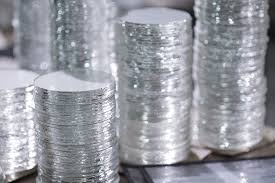
Borosilicate Glass Wafer: Properties, Applications, and Advantages
Borosilicate glass wafers, known for their exceptional thermal, chemical, and mechanical properties, are indispensable in numerous high-tech industries. These wafers are crafted from borosilicate glass, a material distinguished by its low thermal expansion and high resistance to thermal shock, making it ideal for demanding applications in electronics, microfabrication, and scientific research.
What is Borosilicate Glass?
Borosilicate glass is a type of glass composed primarily of silica and boron trioxide. It is renowned for its durability and stability under extreme conditions, such as high temperatures and exposure to chemicals. Borosilicate glass is commonly used in applications requiring precision and reliability.
Properties of Borosilicate Glass Wafers
- Low Thermal Expansion:
- Resistant to cracking or deformation under rapid temperature changes.
- High Thermal Resistance:
- Withstands high temperatures, making it suitable for heat-intensive applications.
- Chemical Durability:
- Resistant to acids, alkalis, and organic solvents.
- Optical Clarity:
- Offers high transparency in the visible and near-infrared spectra.
- Mechanical Strength:
- Provides durability and robustness for handling and machining.
- Surface Flatness:
- Ideal for applications requiring precise alignment and bonding.
Applications of Borosilicate Glass Wafers
- Electronics:
- Used as substrates in microelectromechanical systems (MEMS) and semiconductor manufacturing.
- Microfluidics:
- Serves as a base material for microfluidic devices used in lab-on-a-chip applications.
- Optics and Photonics:
- Employed in optical components, including lenses, mirrors, and windows, due to its optical clarity and thermal stability.
- Biomedical Devices:
- Utilized in biosensors and diagnostic devices, leveraging its biocompatibility and chemical resistance.
- Thin Film Deposition:
- Acts as a substrate for thin-film coatings in scientific and industrial research.
- Solar Energy:
- Integrated into solar panels and concentrators for enhanced thermal and optical performance.
- Scientific Instrumentation:
- Used in precision instruments for research and development, such as spectrometers and laser systems.
Advantages of Borosilicate Glass Wafers
- Thermal Stability:
- Performs reliably under extreme temperature variations.
- Chemical Resistance:
- Offers durability in harsh chemical environments.
- Precision Engineering:
- Manufactured with high levels of surface flatness and dimensional accuracy.
- Versatility:
- Applicable across diverse industries, including electronics, biotechnology, and renewable energy.
- Environmental Friendliness:
- Non-toxic and recyclable, supporting sustainable manufacturing practices.
Challenges in Using Borosilicate Glass Wafers
- Cost:
- High-quality borosilicate glass wafers can be expensive to produce.
- Machining and Handling:
- Brittle nature requires careful machining and handling to prevent damage.
- Scalability:
- Scaling up production while maintaining precision and quality is challenging.
Future Directions
- Advanced Coatings:
- Developing specialized coatings to enhance optical and mechanical properties.
- Integration with Smart Technologies:
- Combining wafers with sensors and IoT devices for advanced applications.
- Customization:
- Expanding manufacturing techniques to produce wafers tailored to specific industrial needs.
- Sustainable Practices:
- Focusing on eco-friendly production methods to minimize environmental impact.
Conclusion
Borosilicate glass wafers are critical components in modern technology, offering unmatched performance in demanding environments. Their unique properties and wide-ranging applications make them indispensable in fields such as electronics, optics, and biomedical engineering. As manufacturing techniques evolve and new applications emerge, borosilicate glass wafers will continue to drive innovation and support the advancement of cutting-edge technologies.
